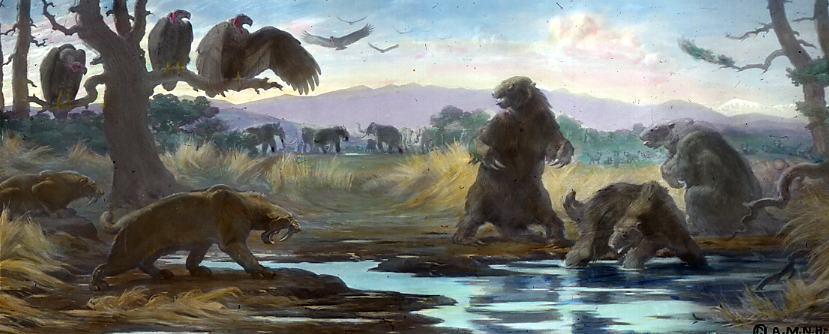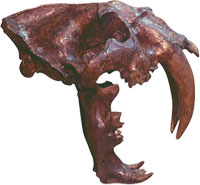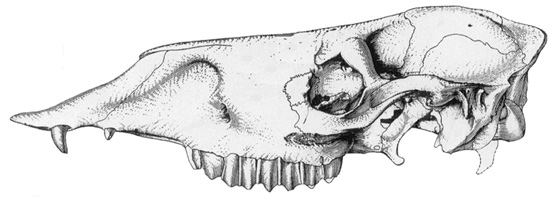I've been meaning to do an entry on the La Brea Tar Pits for quite some time. A recent news tidbit about bee fossils from the Tar Pits reminded me, so now seems as good a time as any.
To go along with that news, here are a few facts about the tar pits:

Also, this is the kind of picture I've always seen of the La Brea Tar Pits. Enormous animals duking it out in some ancient wildnerness, teetering on the edge of the tar pits and about to fall in and become fossils for us to discover centuries later.
(Image from Wikipedia)

One of the many modern-day structures on Wilshire Boulevard: the LA County Museum of Art
(Photo by Luis Sinco at the LA Times)

A popular tour route of Los Angeles and Hollywood, including stops such as Paramount Studios, Melrose Avenue shopping, the Chinese Theatre, Beverly Hills -- and the La Brea Tar Pits, (down at the bottom of this map).
(Map and tour from City Discovery)

Present-day pictures of the tar pits still look rather wilderness-y, with statues of giant now-extinct animals duking it out in the tar pits. Oh, but there's a modern-day building tucked behind those bushes.
(Photo by Roger Weller from Cochise College)

Skull of the saber-toothed "tiger."
(Photo from the University of California Museum of Paleontology)

This is what scientists at the La Brea museum think the sabertooth tiger might have looked like. This is a life-sized puppet, created with help from Jim Henson's Creature Shop.
(Photo from the La Brea Page Museum)

Camelops skull
(Drawing from the National Park Service)

Artist's rendering of what the Camelops may have looked like.
(Drawing from the La Brea Page Museum)

Skeleton of Harlan's Ground Sloth
(Photo from Fossil Treasures of Florida)

Artist's reconstruction of a Harlan's Ground Sloth. This one looks quite friendly.
(Drawing from the La Brea Page Museum)
For a really good pictorial overview of the history of the Tar Pits from 40,000 years ago to today, check out the La Brea Page Museum's Timeline.
Sources
Wilshire Boulevard, a Main Street that stands apart, Los Angeles Times, March 23, 2013
University of California Museum of Paleontology, La Brea Tar Pits, What Is a Sabertooth? Timeline
Howstuffworks, How the La Brea Tar Pits Work
Los Angeles County Natural History Museum Rancho La Brea Collections
La Brea Tar Pits Page Museum Collections
National Park Service, Camelops
San Diego Zoo Library, Extinct Ground Sloth, Tardigrada
Fossil Treasures of Florida, Harlans Ground Sloth
To go along with that news, here are a few facts about the tar pits:
- Since people are always talking about fossils and natural history discoveries and things they learned about animals found in the tar pits that lived a long time ago, I always assumed the Tar Pits were out in the boonies somewhere.

Also, this is the kind of picture I've always seen of the La Brea Tar Pits. Enormous animals duking it out in some ancient wildnerness, teetering on the edge of the tar pits and about to fall in and become fossils for us to discover centuries later.
(Image from Wikipedia)
- Nope. The La Brea Tar Pits are in downtown Los Angeles.
- The park is just off Wilshire Boulevard, which is LA's "Miracle Mile" -- its high-class main street that goes right through downtown and extends all the way to Santa Monica.
One of the many modern-day structures on Wilshire Boulevard: the LA County Museum of Art
(Photo by Luis Sinco at the LA Times)

A popular tour route of Los Angeles and Hollywood, including stops such as Paramount Studios, Melrose Avenue shopping, the Chinese Theatre, Beverly Hills -- and the La Brea Tar Pits, (down at the bottom of this map).
(Map and tour from City Discovery)

Present-day pictures of the tar pits still look rather wilderness-y, with statues of giant now-extinct animals duking it out in the tar pits. Oh, but there's a modern-day building tucked behind those bushes.
(Photo by Roger Weller from Cochise College)
- Long, long ago, back before the tar pits even existed, Los Angeles used to be underwater. The marine animals and fishes that lived in the water died and their skeletons along with all the other stuff that's in water settled at the bottom. Over time, more stuff accumulated, pressing down on those dead fishes et cetera, until they got turned into the good old fossil fuels we all know and love.
- Eventually, the crude oil that was formed seeped up through cracks in the ground to the surface. Wouldn't oil barons of today love that -- a pool of oil just sitting there on the ground.
- But the "lighter components" of the oil evaporate out, and what's left behind is what we call tar.
- Actually, it's asphalt. The black, hot, sticky stuff that road crews onto the street. And did I mention it's sticky?
- To recap, we've got a pool of marine animals which died and got turned into oil, which surfaced and now that's turned into a giant pool of asphalt, which is super sticky. Animals that blunder into it get stuck, can't pull away, and since it's a deep pool of the stuff, they sink into it and die. Then they get turned into fossils. This happened right around the end of the last Ice Age. These are the fossils that people today are excavating and examining.
- Right in the middle of downtown Los Angeles. I still can't get over that.
- Before the pits were turned into a natural park, people did scoop out the tar and use it. Early Native Americans used it as caulk for their canoes and baskets. Later people used the tar for roofing material, just as we use asphalt to make shingles today. It was when they started drilling for oil in the 1800s that they discovered the skeletons in the pits.
- It just so happens that asphalt makes an excellent preservative. Bird bones, exoskeletons of insects, even the unborn larvae of bees are kept so intact, researchers have been able to understand a whole lot of things about plants & animals that don't even exist anymore.
- The asphalt does turn the bones brown, but otherwise, everything is really well-preserved. That's how scientists are able to study such tiny and specific things as the pupae of leafcutter bees.
- As of 1992, people studying the tar pits had unearthed more than 3.5 million individual plants and animals that belong to over 600 species. Of course studies are ongoing, so there are more likely many more specimens in the collection; they just haven't done a census recently.
- Some of the types of animals that have been found in the tar pits include:
- Squirrels
- Rabbits
- Skunks
- Bats
- Herons
- Ducks
- Vultures
- Hawks
- Falcons
- Owls
- Pigeons
- Roadrunners
- Pocket gophers
- Raccoons
- Ground sloths
- Saber-toothed tigers
- Horses
- Cattle
- Camels (I know; camels?!)
- Mastodons
- Elephants
- Bears
- Humans (one person, a woman)
- Can you imagine, being a bird and being all light and feathery and flying around, and then you get some of that dastardly asphalt on your wings. You're a stuck bird and you ain't going no place.
- This list represents only a fraction of the plants & animals & insects that have been found and identified, from 6 pits so far. More research is underway at a new location, and they will also be looking at "microfossils." So who knows what else they may discover.

Skull of the saber-toothed "tiger."
(Photo from the University of California Museum of Paleontology)
- The saber-toothed tiger (Smilodon) is the second-most common mammal fossil that has been found in the tar pits. More than 2,000 of them have been excavated.
- It's not actually that closely related to today's tiger. It was about a foot shorter than our lions today and instead of a long tail, it had a bobtail. Which suggests it didn't run after prey in which case it would need a tail to help it navigate, but rather ambushed its food.
- Their incisors were 8 inches long.
- Most likely, they ate bison and sloths and camels. Yes, camels.
- The saber-toothed tiger went extinct about 10,000 years ago. Which, in paleontology terms, is pretty recent.

This is what scientists at the La Brea museum think the sabertooth tiger might have looked like. This is a life-sized puppet, created with help from Jim Henson's Creature Shop.
(Photo from the La Brea Page Museum)

Camelops skull
(Drawing from the National Park Service)
- The species of camel that has been found in the Tar Pits -- Camelops -- is now extinct. But camels actually originated in North America, not the Middle East.
- Southern California and Idaho were not desert-like back in that time, but were more likely grasslands or even wetlands.
- Since humps are not the sort of thing to get fossilized, scientists aren't sure whether the Camelops had a hump or not.
- It is thought that camels did not adapt to desert conditions until after they arrived in Asia and the Middle East. It is thought that they traveled there over land, which was possible way back then when the geography was much, much different than it is today.
- Camelops are more closely related to today's llamas.

Artist's rendering of what the Camelops may have looked like.
(Drawing from the La Brea Page Museum)

Skeleton of Harlan's Ground Sloth
(Photo from Fossil Treasures of Florida)
- Skeletons of Harlan's Ground Sloth (Paramylodon harlani) and other types of ground sloths, all of which are extinct, have been found in all sorts of places, from La Brea to Antarctica, Florida to Patagonia.
- The Harlan's Ground Sloth lived all across what is now the United States, but mostly in the West.
- These dudes liked the grasslands best, too.
- The Harlan's Ground Sloth was probably about 9 feet tall and weighed somewhere around 2,300 pounds -- "bison-sized" as one site puts it.
- They were probably prey for the saber-toothed tiger (Smilodon).
- They had bony knobs the size of pebbles (osteoderms or dermal ossicles) embedded in their skin which would have acted as a kind of armor.
- Their closest relatives today are anteaters, armadillos, and pangolins. Armadillos & pangolins also have osteoderms, but of a much different shape and growing closer together in complex patterns.

Artist's reconstruction of a Harlan's Ground Sloth. This one looks quite friendly.
(Drawing from the La Brea Page Museum)
For a really good pictorial overview of the history of the Tar Pits from 40,000 years ago to today, check out the La Brea Page Museum's Timeline.
Sources
Wilshire Boulevard, a Main Street that stands apart, Los Angeles Times, March 23, 2013
University of California Museum of Paleontology, La Brea Tar Pits, What Is a Sabertooth? Timeline
Howstuffworks, How the La Brea Tar Pits Work
Los Angeles County Natural History Museum Rancho La Brea Collections
La Brea Tar Pits Page Museum Collections
National Park Service, Camelops
San Diego Zoo Library, Extinct Ground Sloth, Tardigrada
Fossil Treasures of Florida, Harlans Ground Sloth
Excellent way of describing, and good piece of writing to obtain data concerning my
ReplyDeletepresentation subject, which i am going to convey in school.휴게텔